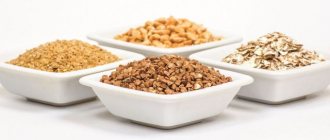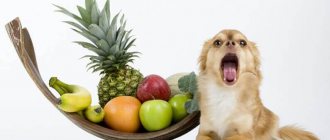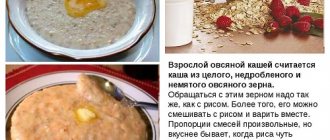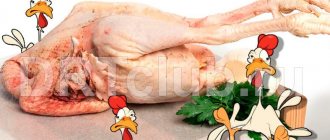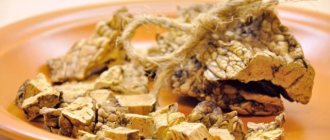Nowadays, many types of dry dog food are produced; its use greatly facilitates the process of feeding the pet for owners. However, owners often believe that animals need to be fed natural products that do not contain dyes or preservatives. These owners use various cereals with added meat and vegetables as the basis of their pet’s diet. In this case, it is important to understand how to cook porridge for dogs and correctly prepare their diet.
Porridge can become the basis of a complete diet
Is it possible to add sugar to dog dishes? Do I need to add salt?
Sugar is a valuable product; the body can release a large amount of energy from it. But it is strictly contraindicated for dogs. Their liver and pancreas are capable of processing glucose, but in extremely small quantities. Excess will cause problems. Dandruff will appear and your eyes will start to run. Very often otitis of unknown etiology and redness of the ears appear. With constant use of sugar, it will begin to act as an allergen. But everything is individual.
The dog receives salt in sufficient quantities from food, provided that the owner provides it with a high-quality diet, whether it be a natural type of feeding or industrial food.
Salt plays an important role in the body's metabolism. The functioning of the heart, the secretion of gastric juice and the functioning of the gastrointestinal tract and nervous system depend on it.
If you add this product to your diet on your own, an overdose with negative consequences is likely. Chronic salt poisoning will lead to death. The lethal dose is 3 g per kilogram of body weight.
A constant excess of salt will lead to urolithiasis, gastrointestinal upset, and metabolic disorders.
With proper nutrition, the dog will receive the required amount of salt, which is contained in the foods it eats: Is porridge given to dogs extra salt? No.
How much to give?
Now that we have decided on the cereals, let’s calculate how much cereal to give the dog at one feeding? The main dish is porridge with meat products and vegetables, given to pets at the rate of 60-70 grams. feed per 1 kilogram of weight per day . This norm is divided into 2 or 3 doses.
A book about dogs (Roucerol Georges V.)
The proportions of the products are as follows: 50% stringy meat and offal; 30% porridge; 20% vegetables and fruits. Thus, per kilogram of dog weight, you need 30-35 grams of meat, 20-25 grams of porridge, and 5-10 grams of vegetables and herbs per day. A dog that weighs 15 kg should eat 150-190 grams with two meals a day. porridge for one feeding or 300-375 gr. in a day.
Which cereals are undesirable for inclusion in the diet and why?
Manna
Semolina is used for primary feeding of puppies, as well as for the treatment and prevention of dogs with gastrointestinal disorders and other diseases. The nutritional properties are unsatisfactory and as a main grain it is contraindicated.
Pearl barley
Pearl barley is not suitable as the main grain in the diet, since it is extremely poorly digestible and often comes out practically undigested. Its nutritional value is unsatisfactory. Even large and giant dogs do not digest it well. With constant feeding, gastrointestinal problems arise, including blockage. Especially if this cereal is not cooked.
Corn
Cannot be used as a staple in the diet. It contains a lot of protein - 3.27 g and fat - 1.35 per 100 g. Dogs will begin to gain weight quickly, this will lead to obesity. The musculoskeletal system will begin to fail. There will be a risk of joint dysplasia, and the spine may begin to sag. This is especially dangerous if the animal does not walk much and does not receive enough physical activity. This cereal is suitable only as an additive to stimulate growth - 10-15% of the diet.
From peas and legumes
None of these grains can be used either as the basis of a dog's diet or as a supplement. They are harmful. The consequence of their use is gastrointestinal upset, flatulence and colic. This occurs due to the fermentation processes that these products cause in the digestive tract.
Millet
When cooked poorly, cereals are poorly digestible and may come out almost unchanged. Can lead to gastrointestinal upset and blockage in case of constant feeding. But when cooked correctly, it is very nutritious - 385 calories. per 100 g. It is also hypoallergenic.
Foods that are not recommended for dogs
Do not give your dog legumes, potatoes, or pearl barley.
Foods that are not recommended to give to your dog:
- Fish and tubular bones
- since fish bones are very sharp, and tubular bones break into sharp fragments, your pet can seriously injure the esophagus and intestines - Salty dishes
- it is not advisable to give moderately salty foods. You need to add a little salt. Since dogs do not have sweat glands, and salt, as is known, retains fluid in the body, edema appears. Which have a depressing effect on the animal - Spicy, smoked, sausages, cheeses, spicy, pickled
- cause swelling and gastrointestinal disorders - Fat and fatty meat
- obesity develops - Onions, garlic, grapes
- these foods are considered poisons for dogs - Legumes
are not digested at all and are not absorbed by fatty acids - Barley
is not digestible - Millet
- with caution, it causes allergies in some dogs - Corn
is poorly digested and takes a long time to digest. - Semolina
- recommended only for puppies - meat
- no harm, but no benefit. Doesn't have time to digest - Cabbage
- in large quantities, bloating due to the large formation of gases. The dog feels discomfort - Potatoes
have a bad effect on J.K.T.
How to cook porridge correctly?
Cereals can be cooked either in the classic way in a saucepan over a fire, or in a slow cooker. The second method will save your time, and the porridge will be more fluffy and nutritious. Here are some porridge recipes for dogs.
On the water
For 1 required volume of porridge we take 2.5-3 volumes of water. Pour the cereal into boiling water and cook for 20-30 minutes. The finished porridge should be soft and as fluffy as possible. It is important to ensure that the porridge does not burn or boil over. If necessary, reduce the gas or add water.
In a multicooker, the proportions are the same, plus you can choose a specific program.
Is it worth cooking with broth or milk?
Broth makes porridge tastier and healthier.
Dogs are more willing to eat it. Maximum nutrients get into the feed. In this case, the meat or offal is boiled in the volume of water that will later be needed to prepare the porridge. It is important to collect the resulting foam. If the broth has boiled away, then boiled water is added to the desired level. The broth can also be prepared from large bones, the fat will be quite decent. The proportions remain the same as on water. Milk contains large amounts of lactose. This compound is easily broken down by puppies, but adults may experience problems with the gastrointestinal tract. It is worth cooking semolina porridge with milk for the primary feeding of young animals. Such porridges are contraindicated for adults and can only be consumed for medicinal purposes. If there are no problems with milk, then it can be given raw (preferably homemade). Goat milk is safer, but also more expensive and is not available everywhere.
Pregnant and lactating
It is better to exclude egg from the diet of pregnant bitches. There are two reasons for this:
- During this period, protein food is important as the basis for future puppies. The cell is of little use in this process.
- A testicle promotes weight gain, and obesity will prevent an easy and painless birth.
You can offer egg to a bitch only if she loved this cereal before pregnancy and now feels the need to enjoy her usual food.
The egg does not play a special role in the diet of a nursing dog - it is given in the same way as in normal times.
How to prepare milk porridge for a puppy?
To the question of how to cook porridge for puppies, the logical answer comes - using milk. For 1 liter of milk we take 6 tablespoons of semolina. We boil the milk. To prevent it from burning, first rinse the pan with ice water. Pour the cereal into the boiled milk, stirring constantly, in a thin stream. Puppies are not allowed to add salt or sugar to their porridge. Cool to room temperature, the product is ready. You can check your temperature by applying the mixture to the back of your wrist. If it doesn’t bake, then you can feed it to little ones.
If you want to cook buckwheat porridge, then the proportion will be 1 to 4 with milk, you need to cook for 35 minutes. over low heat. But this is food for older puppies. It is not suitable for first feeding.
Focus on the individual characteristics of the pet
When choosing a pet for yourself, be sure to consult a breeder or veterinarian about its proper feeding. A healthy, adult dog without any family history can eat almost any cereal without harming its health. An example is the German Shepherd, which can adapt to almost any diet.
The correct dog porridge should be chosen much more carefully if we are talking about small puppies or a breed with digestive problems. These are the majority of decorative breeds that have a long path of genetic mutations behind them. Animals with congenital pathologies, metabolic disorders, or those who have suffered serious illnesses are no exception. In any of these cases, the choice is limited to buckwheat and rice. If an allergic reaction is observed (redness of the ears, itchy skin), then the cereal component is limited to brown or brown rice.
How to cook cereal?
Cereals for animals are cooked in the same way as for people. It is important to remember that you need to add 10 times less salt than yourself or not add salt at all. Sugar is also undesirable. It is recommended to cook the cereals 1-2 times. You need to make sure that there are no pebbles, mouse droppings, moth larvae, etc. in the cereal. The porridge should not be overcooked. Any spices, seasonings and flavor enhancers are prohibited. This is an allergy threat!
Barley
The grains are carefully sorted and washed. Dust and possible husks are removed. Pour the cell into the pan and fill it with water. Stir and everything will float to the surface. Pour the cereal into cold water and bring to a boil. After 20 min. simmer over low heat. Porridge is taken in a ratio of 1 to 2.5 with water, and for puppies - up to 4 parts of water.
Rice
Rice is cooked in a ratio of 1 to 2 with water. The rice is first washed several times until the water is clear. The cereal is poured into boiling water. It is advisable to take a thick-walled pan - it is less likely to burn. Boil for 7 minutes. over high heat and then 15 minutes. let it simmer on low heat. There is no need to remove the lid and stir the dish. After cooking, let it sit for 20 minutes and add the rest of the selected dog diet.
Wheat
This type of cereal is cooked in the same way as barley. It is important to remember that wheat grains can cause itching in puppies - an allergic reaction to gluten.
When using a multicooker, you should use the instructions included with the product and then mix the porridge with all the prescribed ingredients of the diet, as described above.
Oatmeal and oatmeal
These are two names for the same cereal (Hercules is the trademark under which oatmeal is sold, the name has become a household name). It is prepared according to the same procedure as written on the package for humans. There is no need to rinse the product; you can check whether there are any impurities or unnecessary things in the oatmeal. The average proportion of water and porridge is 1.5 to 1. Cook for 20 minutes. If the oat flakes are small (meaning rolled oats), then they will be ready in 5 minutes; they are generally brewed, which is very convenient for a quick breakfast, but the dog still needs to boil them a little. The finished porridge does not foam. Old flakes are bitter, and the animal may refuse to eat.
Buckwheat
The proportion of buckwheat with water will be 1 to 2. Buckwheat must be removed from possible foreign impurities. It is advisable to take a thick-walled saucepan or cast iron cauldron. You can add vegetable oil. There is no point in frying grains for an animal. Cook for 20-25 minutes after boiling. Collecting foam. If necessary, add water. We add meat and offal according to the proportion of your pet’s diet.
If you feel bad from a cellulose
Yachka extremely rarely causes allergies, and it is also impossible to get poisoned by it (of course, if the porridge has not gone sour). Therefore, if your pet feels ill after a hearty meal, this is most likely a disorder. It will manifest itself in diarrhea, and undigested eggs will be clearly visible in the stool.
There is no need to worry: it is enough to offer the animal plenty of warm drink, skip 1-2 feedings, and feed activated carbon (at the rate of 1 tablet per 10 kg of weight). And, of course, do not scold for a damaged carpet - the disorder from the pitting comes suddenly, and the dog may simply not be able to resist.
Barley porridge should be temporarily excluded from the diet; it is better to replace it with rice porridge, which has astringent properties.
How to cook porridge?
To do this, prepare the cereal as described above and then add all the ingredients that you have chosen for your pet’s complete diet.
With meat
Add pre-cooked meat to the prepared porridge. Suitable beef, horse meat, lamb. If you use offal, then they are related to meat as 1 to 1.25. Chop the meat or offal finely to mix well with the porridge. This way the animal will not pick and eat everything. We also add brewer's yeast, meat and bone meal, and granulated calcium according to the instructions on the package. On average we take 30% porridge, 65% meat or offal, 5% other ingredients.
With minced meat or fish
Minced meat is not recommended for dogs as food. It is poorly absorbed. Meat or offal in pieces is much healthier; they stimulate the gastrointestinal tract. Minced meat does not satiate the animal well. Store-bought minced meat is very questionable in composition and is almost always very fatty. This also applies to minced fish. Its composition is unpredictable. Although many owners of small breeds give them minced meat prepared at home.
With vegetables
Vegetables contain a large amount of useful substances. But the dog does not need them in large quantities. Carrots, zucchini, potatoes, pumpkin, cucumbers are suitable, but in small quantities. They are boiled together with the broth, cut into small cubes. Then add and mix with porridge. Their share in the diet will be approximately 5% of the total mass. Cabbage, peas, broccoli, eggplants, and tomatoes are extremely poorly tolerated by four-legged animals, they can even be dangerous.
Apples, cucumbers, pumpkin and carrots can be given separately raw. It’s good to make vegetable porridge by grating them using a medium grater, but without chopping them into puree. If the dog simply does not eat vegetables, then they can be mixed into the prepared cereal porridge.
Do you need vitamins?
Many dogs are selective about vegetables, greens and fruits. Such “gourmets” are recommended to add daily supplements to their basic diet, for example:
- Nutri-Vet Multi-Vite;
- 8 in 1 Excel Multi Vitamin.
If the dog’s diet is sufficiently varied and balanced, vitamins are given in courses of 4-8 weeks once a quarter or as needed (periods of increased stress for sporting and hunting dogs, cold seasons, seasonal shedding), for example:
- Beaphar Laveta Super;
- Canina Enzym – Hefe;
- Phytoelite.
Vitamins are selected taking into account the size of the dog. Feeding a St. Bernard complex to a Yorkie will not be beneficial. An excess of vitamins is just as dangerous as a deficiency.
There is no need to change the diet if it meets all the dog’s needs. The body adjusts and adapts to the digestion of certain foods over a long period of time. Sudden changes (even switching from one grain to another) can cause digestive upset.
conclusions
With a natural type of feeding, porridges occupy an important place in the diet - 25-40%. There is a large selection from their variety. NOT all cereals are equally healthy, and some can be harmful. How to prepare porridge for dogs depends on the grain chosen. A multicooker will significantly save your labor costs. Adding salt is not recommended, and sugar, spices, seasonings and flavor enhancers are completely prohibited. Vegetables are a good addition to the diet, but not all are beneficial to the animal. Porridge should be prepared for 1-2 meals, milk porridge only for 1 meal. Dogs that eat porridge are energetic, look healthy, and grow and develop well.
Please follow and like us:
Nikitin Sergey
I write about dogs based on the experience and knowledge gained during my studies as a veterinarian, work in my specialty, and simply from observing my pets.
Harm and allergies
A food allergy to barley is a very rare occurrence and there is little to worry about. However, excessive consumption of egg can cause other problems in the dog, namely:
- obesity. If there is too much barley in the diet and the dog doesn’t move much, weight gain and all the associated health problems are guaranteed. This is especially dangerous for older animals;
- stomach upset. Yachka, like pearl barley, can be poorly digested and leave the dog’s stomach almost in its original form.
Important: if you feed an animal every day, general health problems will soon begin: muscle atrophy, weakness and lethargy, arthritis, hair loss and dullness, caries. To avoid this, you need to follow a diet based on meat and offal, vegetables and a variety of cereals.
Content
1. Can a dog have rice? – We consider the positive aspects 2. What risks are present 3. How to choose? 4. Cooking process
Any owner of a four-legged barking friend wishes him nothing but good and health. And to achieve this goal, you need to properly work out your diet. People often wonder whether a dog can eat rice, buckwheat and other grains. It is certainly and definitely possible, and even necessary, especially in cases where natural food similar to human food is used. But it is very important to correctly determine the type of rice, as well as the serving sizes.



